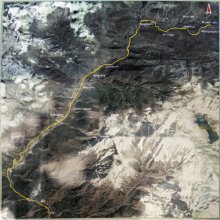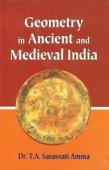Kshetra, Kṣetra, Kṣētra: 40 definitions
Introduction:
Kshetra means something in Buddhism, Pali, Hinduism, Sanskrit, Jainism, Prakrit, the history of ancient India, Marathi, Hindi. If you want to know the exact meaning, history, etymology or English translation of this term then check out the descriptions on this page. Add your comment or reference to a book if you want to contribute to this summary article.
The Sanskrit terms Kṣetra and Kṣētra can be transliterated into English as Ksetra or Kshetra, using the IAST transliteration scheme (?).
Images (photo gallery)
In Hinduism
Shaktism (Shakta philosophy)
Source: Google Books: ManthanabhairavatantramKṣetra (क्षेत्र) (lit. ‘field’ or ‘area of ground’) refers to “sacred fields” (cf. Upakṣetra, Āyāyana), visited by the Goddess on her pilgrimage, according to Tantric texts such as the Kubjikāmata-tantra, the earliest popular and most authoritative Tantra of the Kubjikā cult.—Accordingly, “[The Goddess] went to Devīkoṭa, (arriving there) in a moment, and with a powerful look (āloka) (it became a sacred site [i.e., kṣetra]. Then she went to) Aṭṭahāsa, (so called) because she laughed (there) loudly. (Then she went to) Kolāgiri, Ujjenī, Prayāga, Varṇā (i.e. Vārāṇasī), Viraja, Ekāmra and other (places) and (then on to) another universe. [...] There are secondary sacred sites (upakṣetra) (and other sacred places), sacred bathing sites (tīrtha) and meeting grounds (saṃdoha), of many kinds wherever the goddess went and wherever she cast her gaze”.
Note: The reference here to secondary or ‘nearby’ fields (upakṣetra) implies that the eight listed in the previous verses are sacred fields (kṣetra). As these are not mentioned in the version found at the end of chapter six of our text, this term is replaced by the nondescript variant āyātana—“sacred site” when this verse is quoted in the Kumārikākhaṇḍa.
Kṣetra is the oldest term for a sacred site.—It appears already in the middle Vedic period in the name of the most famous kṣetra and probably the earliest one—Kurukṣetra.—The Śrīmatottara says that: “(The goddess) conceived the sacred fields (kṣetra) by means of the mantras of the fields. [...] worshipped, (these) eight (goddesses) who have authority over the sacred fields (kṣetra), bestow boons. The goddess assumed many forms in relation to the eight Kulas”.
Source: Manblunder: Lalitha SahasranamaKṣetra is the physical body and kṣetrajña is the soul. Kṣetra is made up of thirty six tattvas (some take only twentyfour) or principles. Kṣetra is gross and kṣetrajña is subtle. Kṣetra is perishable, whereas the knower of Kṣetra, kṣetrajña is eternal and imperishable.

Shakta (शाक्त, śākta) or Shaktism (śāktism) represents a tradition of Hinduism where the Goddess (Devi) is revered and worshipped. Shakta literature includes a range of scriptures, including various Agamas and Tantras, although its roots may be traced back to the Vedas.
Vastushastra (architecture)
Source: Wisdom Library: Vāstu-śāstra1) Kṣetra (क्षेत्र) refers to a “temple”, and in a broader sense represents “devotional place” or “residence of God”. It is one of commonly used names for a temple, as found in Vāstuśāstra literature such the Mayamata and the Mānasāra.
2) Kṣetra (क्षेत्र) is a Sanskrit technical term denoting a “residence” in general, according to the lists of synonyms given in the Mayamata XIX.10-12 and the Mānasāra XIX.108-12, both populair treatises on Vāstuśāstra literature.
Source: McGill: The architectural theory of the MānasāraKṣetra (क्षेत्र).—The ceremony of installation of image and inauguration of the temple establishes the dwelling of the deity in the kṣetra, “ordered site”. By this, the perception of divine presence in the location is officially pronounced and made accessible to the wider populace in the mode of darśana, the mutual “seeing” of devotee and deity. Darśana marks the culmination of devotional worship in Śaivism.

Vastushastra (वास्तुशास्त्र, vāstuśāstra) refers to the ancient Indian science (shastra) of architecture (vastu), dealing with topics such architecture, sculpture, town-building, fort building and various other constructions. Vastu also deals with the philosophy of the architectural relation with the cosmic universe.
Purana and Itihasa (epic history)
Source: archive.org: Puranic EncyclopediaKṣetra (क्षेत्र).—Sacred spots. In Malayālam it means Temples also. General information. The temples of India are reflections of the outward form or body of man. As the soul lives in the body of man, God dwells in the temples. The stone, rock, marble, metals etc. are equal to the bones of the body of a man. Two types of temples. Temples are of two types. One type is the Grāmadevatā temples. These are temples in which goddess Bhadrakālī is consecrated and worshipped for the protection of villages and cities. The second type is of special temples. These are temples specially meant for a particular god or goddess. Thus there are temples for Viṣṇu, Śiva, Gaṇapati and so on. Grāmadevatā temples. Worship of Bhadrakālī existed in India from very early times. When Mohanjodaro and Harappa were excavated idols of Devī (goddess) more than 4000 years old, were obtained from there. During the prevalence of Buddhism in India the goddesses Yaksī and Hāritī were worshipped in India. Later when Hinduism was revived these goddesses took their places in it as the goddesses of Hindu Purāṇas and epics. The Kālī temples of Ujjayinī and Calcutta are famous. In the Cidambara temple also the main deity is Kālī. The legend is that Paramaśiva defeated Kālī in a dance. In Mysore Cāmuṇḍī (Kālī) is worshipped as chief goddess or family goddess. Kāmākṣī in Kāñcī, Mīnākṣī in Madura (South India), Mūkāmbikā in North Karṇāṭaka and so on are the gentle and peaceful forms of Kālī. Devas (gods). In many of the temples in South India, Munīśvaran and Karuppan are the grāmadevatās (village gods). In some places Bhairava also is worshipped as grāmadevatā. In certain other places Vīran, Irulan, Kāreṭṭi, Noṇḍi and Pañcaruli are worshipped. Śāstā or Ayyappan has a prominent place among the village gods. Importance is attached to Śāstā or Ayyappan mostly in Kerala and Tamil Nāḍu. (See full article at Story of Kṣetra from the Puranic encyclopaedia by Vettam Mani)
Source: Cologne Digital Sanskrit Dictionaries: The Purana IndexKṣetra (क्षेत्र).—(avyaktam) and kṣetrajña are Brahmā; the union of these two leads to the eternal being; also aviṣaya and viṣaya.*
- * Brahmāṇḍa-purāṇa I. 3. 37; Vāyu-purāṇa 102. 34-6, 111-14.

The Purana (पुराण, purāṇas) refers to Sanskrit literature preserving ancient India’s vast cultural history, including historical legends, religious ceremonies, various arts and sciences. The eighteen mahapuranas total over 400,000 shlokas (metrical couplets) and date to at least several centuries BCE.
Jyotisha (astronomy and astrology)
Source: Wikibooks (hi): Sanskrit Technical TermsKṣetra (क्षेत्र).—Closed figure. Note: Kṣetra is a Sanskrit technical term used in ancient Indian sciences such as Astronomy, Mathematics and Geometry.

Jyotisha (ज्योतिष, jyotiṣa or jyotish) refers to ‘astronomy’ or “Vedic astrology” and represents the fifth of the six Vedangas (additional sciences to be studied along with the Vedas). Jyotisha concerns itself with the study and prediction of the movements of celestial bodies, in order to calculate the auspicious time for rituals and ceremonies.
Ayurveda (science of life)
Nighantu (Synonyms and Characteristics of Drugs and technical terms)
Source: Wisdom Library: Raj NighantuKṣetra (क्षेत्र) refers to “land”, as defined in the first chapter (ānūpādi-varga) of the 13th-century Raj Nighantu or Rājanighaṇṭu (an Ayurvedic encyclopedia).
Accordingly, the five classifications of land (kṣetra) are defined according to the concept of the five elements known as Pañcabhūta (Pañcamahābhūta):
- pārthiva-kṣetra (earthen land),
- āpya-kṣetra (watery land),
- taijasa-kṣetra (bright land),
- vāyavīya-kṣetra (aerial land),
- āntarikṣa-kṣetra (heavenly land).

Āyurveda (आयुर्वेद, ayurveda) is a branch of Indian science dealing with medicine, herbalism, taxology, anatomy, surgery, alchemy and related topics. Traditional practice of Āyurveda in ancient India dates back to at least the first millenium BC. Literature is commonly written in Sanskrit using various poetic metres.
Vaishnavism (Vaishava dharma)
Source: Pure Bhakti: Bhagavad-gita (4th edition)Kṣetra (क्षेत्र) refers to “field of the body (13.1)”. (cf. Glossary page from Śrīmad-Bhagavad-Gītā).

Vaishnava (वैष्णव, vaiṣṇava) or vaishnavism (vaiṣṇavism) represents a tradition of Hinduism worshipping Vishnu as the supreme Lord. Similar to the Shaktism and Shaivism traditions, Vaishnavism also developed as an individual movement, famous for its exposition of the dashavatara (‘ten avatars of Vishnu’).
Yoga (school of philosophy)
Source: Brill: Śaivism and the Tantric Traditions (yoga)Kṣetra (क्षेत्र) refers to “regions”, according to the Amṛtasiddhi, a 12th-century text belonging to the Haṭhayoga textual tradition.—Accordingly, “There are oceans, rivers, regions (kṣetra) [and] guardians of the regions; gathering places, sacred sites, seats [of deities and] the deities of the seats”.

Yoga is originally considered a branch of Hindu philosophy (astika), but both ancient and modern Yoga combine the physical, mental and spiritual. Yoga teaches various physical techniques also known as āsanas (postures), used for various purposes (eg., meditation, contemplation, relaxation).
Ganitashastra (Mathematics and Algebra)
Source: archive.org: Hindu MathematicsKṣetra (क्षेत्र) or Kṣetragata refers to the “geometrical” (method of demonstration), according to the principles of Bījagaṇita (“algebra” or ‘science of calculation’), according to Gaṇita-śāstra, ancient Indian mathematics and astronomy.—The method of demonstration has been stated to be always of two kinds according to Bhāskara II in the Bījagaṇita:—“one geometrical (kṣetra-gata) and the other symbolical (rāśi-gata)”. We do not know who was the first in India to use geometrical methods for demonstrating algebraic rules. Bhāskara II (1150) ascribes it to ancient teachers.

Ganitashastra (शिल्पशास्त्र, gaṇitaśāstra) refers to the ancient Indian science of mathematics, algebra, number theory, arithmetic, etc. Closely allied with astronomy, both were commonly taught and studied in universities, even since the 1st millennium BCE. Ganita-shastra also includes ritualistic math-books such as the Shulba-sutras.
Sports, Arts and Entertainment (wordly enjoyments)
Source: archive.org: Syainika Sastra of Rudradeva with English Translation (art)Kṣetra (क्षेत्र) refers to “corn fields” (used by hunters), according to the Śyainika-śāstra: a Sanskrit treatise dealing with the divisions and benefits of Hunting and Hawking, written by Rājā Rudradeva (or Candradeva) in possibly the 13th century.—Accordingly, “Hunting by lying in wait is that in which a bowman singly or jointly with others awaits the approach of animals and then pierces them with poisoned darts. It succeeds where there are trees of the Beleric myrobalan, in corn fields (kṣetra), and in places for drinking water, An easy success in killing lions and other ferocious animals is achieved by placing the carcass of a cow in a suitable position”.

This section covers the skills and profiencies of the Kalas (“performing arts”) and Shastras (“sciences”) involving ancient Indian traditions of sports, games, arts, entertainment, love-making and other means of wordly enjoyments. Traditionally these topics were dealt with in Sanskrit treatises explaing the philosophy and the justification of enjoying the pleasures of the senses.
General definition (in Hinduism)
Source: WikiPedia: Hinduism1) Kṣetra (क्षेत्र, “holy city”):—A Kṣetra is a sacred ground where Mokṣa can be obtained. The Garuda Purana enumerates seven cities as sources of Mokṣa:
- Ayodhya,
- Mathura,
- Māyā (Haridwar),
- Kāsi (Varanasi),
- Kāñchī,
- Avantikā (Ujjain), and
- Dvārāvatī (Dvārakā).
2) A Kṣetra (Sanskrit: क्षेत्र "field, area, tract of land") denotes a holy precinct or temenos. The Kurukshetra specifically is the "field" or "precinct" where the Pandavas and Kauravas fought a religious war as told in the Bhagavad Gita section of the Mahabharata. In common parlance, kshetra may denote a place where there is a temple or where there is held to have been a person or event of sacred, religious or dharmic importance. As sacred precincts, both yantras and mandalas are kshetras.
In Hinduism, Tirtha and Kshetra are two terms denoting sites of pilgrimage. The Indian subcontinent is full of Tirthas and Kshetras.
3) Buddhism has two analogues to the kshetra, the Pure Land or buddhakṣetra and the refuge tree.
Source: WikiPedia: HinduismKṣetra (क्षेत्र) is a Sanskrit word referring to “field of activities”, the body of the conditioned soul.
In Buddhism
Tibetan Buddhism (Vajrayana or tantric Buddhism)
Source: Google Books: Manthanabhairavatantram (tantric buddhism)Kṣetra (क्षेत्र) refers to a “sacred field” and represents one of the various classes of sacred sites, according to the Netravibhaṅga, a commentary on the Hevajratantra by Dharmakīrti.—Accordingly, “It is called a ‘seat’ (pīṭha) because one always stays there and performs the practice, also because the yogis stay there. Because it is near to that place, it is called ‘nearby seat’ (upapīṭha). It is called ‘field’ (kṣetra), because it produces good qualities, also because the mother-goddesses stay there. Because it is near to there, it is called ‘near-by field’ (upakṣetra). Because one desires and yearns, it is called Chando. Because it is near there, it is called ‘near-by Chando’. It is called ‘meeting place’ (melāpaka) because it is the site of a place, [for example] Magadha and Aṅgamagadha. It is called ‘near-by meeting place’ because it is near there. It is called ‘cemetery’ (śmaśāna) because no discriminating thought (vikalpa) arises and because there are many corpses. It is called ‘near-by cemetery’, because it is near to there”.
Source: academia.edu: A Critical Study of the Vajraḍākamahātantrarāja (II)Kṣetra (क्षेत्र) is one of the Pīṭhādis (group of districts) present within the Vākcakra (‘circle of word’) which is associated with the Ḍākinī named Bhūcarī (‘a woman going on the ground’), according to the 9th-centruy Vajraḍākatantra.
The Pīṭhādi named Kṣetra within the Vākcakra contains the following four districts or seats:
- Kāmarūpa,
- Oḍra.
Kṣetra (क्षेत्र) refers to a type of power place where Yogins and Yoginīs congregate, according to the Sampuṭodbhavatantra chapter 5.—Accordingly, “[Vajragarbha asked:]—‘Blessed One, what places are places of gatherings?’ [The Blessed One said:]—‘There are pīṭhas and auxiliary pīṭhas, And likewise, kṣetras and auxiliary kṣetras. There are also chandohas and auxiliary chandohas, melāpakas and auxiliary melāpakas. There are charnel grounds and auxiliary charnel grounds, pīlavas and auxiliary pīlavas. These are the twelve types of meeting places. The lord of the ten bhūmis has not specified Any places other than these twelve’. [...]”.
Kṣetra in Tibetan: ཞིང་། [zhing].

Tibetan Buddhism includes schools such as Nyingma, Kadampa, Kagyu and Gelug. Their primary canon of literature is divided in two broad categories: The Kangyur, which consists of Buddha’s words, and the Tengyur, which includes commentaries from various sources. Esotericism and tantra techniques (vajrayāna) are collected indepently.
Mahayana (major branch of Buddhism)
Source: academia.edu: A Study and Translation of the GaganagañjaparipṛcchāKṣetra (क्षेत्र) refers to “fields”, according to the Gaganagañjaparipṛcchā: the eighth chapter of the Mahāsaṃnipāta (a collection of Mahāyāna Buddhist Sūtras).—Accordingly, “When this had been said, the Lord said to the Bodhisattva, the great being Gaganagañja: ‘[...] Just as the sky is unconditioned, the same way, [the Bodhisattva] gives a gift without conditions. Just as the sky is beyond ideation, the same way, [the Bodhisattva] gives a gift with no basis in consciousness. Just as the sky is spread on all Buddha-fields (sarva-buddha-kṣetra-spharaṇa), the same way, [the Bodhisattva] gives a gift in order to pervade all living beings with friendliness. [...]’”.

Mahayana (महायान, mahāyāna) is a major branch of Buddhism focusing on the path of a Bodhisattva (spiritual aspirants/ enlightened beings). Extant literature is vast and primarely composed in the Sanskrit language. There are many sūtras of which some of the earliest are the various Prajñāpāramitā sūtras.
In Jainism
General definition (in Jainism)
Source: archive.org: Jaina YogaKṣetra (क्षेत्र, “land”) refers to one of the classes of the external (bahya) division of attachment (parigraha) and is related to the Aparigraha-vrata (vow of non-attachment). Kṣetra is listed in Śvetāmbara sources such as Devagupta’s Nava-pada-prakaraṇa with Laghu-vṛtti (58), and in Digambara sources such Cāmuṇḍarāya’s Caritrasāra (p. 7).
Land (kṣetra) is of three types:
- setu-kṣetra—land irrigated artificially by norias (araghaṭṭa) or other means;
- ketu-kṣetra—dry farming land depending on rain;
- miśra—irrigated land which also receives rain.
1) Kṣetra (क्षेत्र, “abode”) refers to “place /abode or field touched”, according to the 2nd-century Tattvārthasūtra 1.8. The present abode /area/volume occupied by an entity at present is called its abode (kṣetra).
Accordingly, “the categories (padārtha) and their details are undefrstood in detail in terms of existence, number (enumeration), place or abode (kṣetra), extent of space touched (pervasion), continuity /time, interval of time, thought-activity, and reciprocal comparison”.
2) Kṣetra (क्षेत्र, “place”) refers to a category of both anugāmi (following) and ananugāmi (preceding), according to Tattvārthasūtra 1.21. Anugāmi and Ananugāmi refer to a type of guṇapratyaya: a category of knowledge (jñāna) obtained by clairvoyance (avadhi-jñāna).
What is meant by kṣetra-anugāmi clairvoyance? This clairvoyant knowledge goes from one place to another with the owner. What is meant by kṣetra-ananugāmi (clairvoyant knowledge that does not follow its owner to another place)? It is the clairvoyance knowledge that does not go with the owner from one place to another.
3) Kṣetra (क्षेत्र, “spatial-range”).—The province in which the mind of others can be cognized by telepathy (manaḥparyaya) is called its spatial-range (kṣetra). according to the 2nd-century Tattvārthasūtra 1.25, “Telepathy (manaḥparyaya) and clairvoyance (avadhi) differ with regard to purity (viśuddhi), spatial-range (kṣetra), and species of the knower and the nature of the objects identified by them”.
Source: Encyclopedia of Jainism: Tattvartha Sutra 3: The Lower and middle worldsKṣetra (क्षेत्र, “space”) or Kṣetrariddhi refers to “extraordinary power to enhance a space of small capacity to a space with extraordinarily large space” and represents one of the eight types of ṛddhi (extraordinary powers), that can be obtained by the Ārya (civilized people): one of the two classes of human beings, according to the 2nd-century Tattvārthasūtra 3.46.—Some ascetics attain extraordinary powers to produce worldly miracles. Such attainments are called ṛddhi. There are eight types of such extraordinary powers (e.g., Kṣetra).
Kṣetra-ṛddhi (extraordinary power of enhancing space) is of two types namely:
- space enhancing (achinna-riddhi),
- avacchinna-riddhi.
Kṣetra (क्षेत्र) refers to the seven zones of Jambudvīpa.—There are six mighty mountains dividing the Jambudvīpa into 7 zones (kṣetra), viz—
- Bharata kṣetra,
- Haimavata-kṣetra,
- Hari-kṣetra,
- Videha-kṣetra,
- Ramyaka-kṣetra,
- Hairaṇyavata-kṣetra,
- Airāvata-kṣetra.
The three zones i.e. Bharata-kṣetra, Videha-kṣetra and Airāvata-kṣetra are also known as karma-bhūmi because of the practice of austerities done here and so liberation is possible and the Tīrthānkaras preach Jaina doctrine here. The other four zones i.e. Ramyaka, Hairaṇyavata, Haimavata and Hari-kṣetra are known as akarmabhūmi, or bhogabhūmi as human live in a sinless life of pleasure and so no religion on liberation is possible.
Source: The University of Sydney: A study of the Twelve ReflectionsKṣetra (क्षेत्र) refers to the “place”, according to the 11th century Jñānārṇava, a treatise on Jain Yoga in roughly 2200 Sanskrit verses composed by Śubhacandra.—Accordingly, “Sentient beings, inflamed by very intense pleasure [and] unsteady from affliction by wrong faith, wander about in a five-fold life that is difficult to be traversed. It has been stated at length that the cycle of rebirth which is full of suffering is five-fold on account of combining substance, place (kṣetra), right time, life and intention (dravyakṣetratathākālabhavabhāvavikalpataḥ)”.

Jainism is an Indian religion of Dharma whose doctrine revolves around harmlessness (ahimsa) towards every living being. The two major branches (Digambara and Svetambara) of Jainism stimulate self-control (or, shramana, ‘self-reliance’) and spiritual development through a path of peace for the soul to progess to the ultimate goal.
India history and geography
Source: archive.org: Personal and geographical names in the Gupta inscriptionsKṣetra (क्षेत्र) refers to a name-ending for place-names mentioned in the Gupta inscriptions (reigned from 3rd century CE). Kṣetra originally meant an agricultural field, in which sense its use survives, kṣetra came to be used as a place-name suffix as we find in the word Kurukṣetra. As a suffix in composition it signified simply a ‘field’ for the word preceding it. For example Karmakṣetra, Dharmakṣetra, Raṇakṣetra, Siddhakṣetra, Sureśvarīkṣetra.
Kṣetra is changed into:
- chatra as Ahikṣetra, Ahichatra
- cchatra as Ahikṣetra, Ahicchatra.
In Prakrit kṣetra changes to kheṭṭa meaning ‘a land for agriculture’, country, village and city, etc.
Analogous to kheṭṭa is the word ‘kheḍa’ or ‘kheṭa’ which means ‘a city surrounded by rivers and mountains’. Kheṭa meaning ‘a small hamlet’ is also found in Pāṇini (VI. 2. 126). The Samarāṅgaṇasūtradhāra defines ‘kheṭa’ as the half of a city and the grāma as the half of a ‘kheṭa’. According to Monier Williams kheṭa means a village, residence of peasants and farmers, small town (half of a pura).
Source: Cologne Digital Sanskrit Dictionaries: Indian Epigraphical GlossaryKṣetra.—(EI 24), a department or committee. (SII 1), a sacred place. Cf. Varāha-kṣetra. Note: kṣetra is defined in the “Indian epigraphical glossary” as it can be found on ancient inscriptions commonly written in Sanskrit, Prakrit or Dravidian languages.
Source: Yale Journal of Music & Religion: Ritual Music in Contemporary Brahmanical Tantric Temples of KeralaKṣetra (क्षेत्र) (also known as ambalam) refers to certain Brahmanical temples from 9th century Kerala—The earliest Brahmanical temples date from the ninth century, but the architectural design evolved over several centuries and culminated in the systematization of a typical style sanctioned by the Tantrasamuccaya. Such temples, alternatively called kṣetras or ambalams, consist of six parts: (1) the shrine, or śrīkōvil, and (2) the pañca-prākāras, the five successive enclosures surrounding it.

The history of India traces the identification of countries, villages, towns and other regions of India, as well as mythology, zoology, royal dynasties, rulers, tribes, local festivities and traditions and regional languages. Ancient India enjoyed religious freedom and encourages the path of Dharma, a concept common to Buddhism, Hinduism, and Jainism.
Languages of India and abroad
Marathi-English dictionary
Source: DDSA: The Molesworth Marathi and English Dictionarykṣētra (क्षेत्र).—n (S) A field. 2 A pure or sacred spot; a place of pilgrimage; a spot viewed as the field or dwelling-place of the gods. 3 A place, a spot, a superficies, a portion of space. 4 A body, a thing considered as having the geometrical dimensions, any extended figure. 5 An aggregate of twelve Shaligram. 6 The body (of a man or an animal) considered as the field of the indwelling and working of the soul. 7 The wife of; considered as the field of her husband. 8 (With implication of kṣētra as the Belly.) A total abstinence (for a time) from food, a perfect fast. v paḍa, hō, ghāla. Note. kṣētra is never used of religious fasting. 8 Plane figure, geometry. 9 A diagram. 10 (As a field of sacred things or a scope for worship--) An aggregate of 24 śāligrāma or 11 bāṇa or 21 gaṇapati from the river narmadā, or of 12 sūrya (i. e. sūryakānta) and of 8 dēvī (i. e. suvarṇamukhī).
Source: DDSA: The Aryabhusan school dictionary, Marathi-Englishkṣētra (क्षेत्र).—n A field. A sacred spot. A place. A diagram.
Marathi is an Indo-European language having over 70 million native speakers people in (predominantly) Maharashtra India. Marathi, like many other Indo-Aryan languages, evolved from early forms of Prakrit, which itself is a subset of Sanskrit, one of the most ancient languages of the world.
Sanskrit dictionary
Source: DDSA: The practical Sanskrit-English dictionaryKṣetra (क्षेत्र).—[kṣi-ṣṭran] A fiield, ground, soil; चीयते बालिशस्यापि सत्क्षेत्रपतिता कृषिः (cīyate bāliśasyāpi satkṣetrapatitā kṛṣiḥ) Mu.1.3.
2) Landed property, land.
3) Place, abode, region, repository; कपटशतमयं क्षेत्रमप्रत्ययानाम् (kapaṭaśatamayaṃ kṣetramapratyayānām) Pañcatantra (Bombay) 1.191; Bhartṛhari 1.77; Meghadūta 16.
4) A sacred spot, a place of pilgrimage; क्षेत्रं क्षत्रप्रधनपिशुनं कौरवं तद्भजेथाः (kṣetraṃ kṣatrapradhanapiśunaṃ kauravaṃ tadbhajethāḥ) Meghadūta 5; Bhagavadgītā (Bombay) 1.1.
5) An enclosed spot of ground, portion or space, superficies, circuit.
6) Fertile soil.
7) Place of origin; Bhāgavata 2.6.1.
8) A wife; अपि नाम कुलपतेरियमसवर्णक्षेत्रसंभवा स्यात् (api nāma kulapateriyamasavarṇakṣetrasaṃbhavā syāt) Ś.1; Manusmṛti 3.175; वृद्धस्तु व्याधितो वा राजा (vṛddhastu vyādhito vā rājā) ... क्षेत्रे बीजमुत्पादयेत् (kṣetre bījamutpādayet) Kau. A.1.17.
9) The sphere of action, the body (regarded as the field of the working of the soul); योगिनो यं विचिन्वन्ति क्षेत्राभ्यन्तर- वर्तिनम् (yogino yaṃ vicinvanti kṣetrābhyantara- vartinam) Kumārasambhava 6.77; Bhagavadgītā (Bombay) 13.1,2,3.
1) The mind.
11) A house; a town.
12) A plane figure, as a triangle.
13) A diagram.
14) A sign of the zodiac.
15) (in chiromancy) A certain portion marked out on the palm; क्षेत्रं मृजां च विधिवत्कुशलोऽवलोक्य सामुद्रविद्वदति यातमनागतं च (kṣetraṃ mṛjāṃ ca vidhivatkuśalo'valokya sāmudravidvadati yātamanāgataṃ ca) Bṛ. S.68.1.
Derivable forms: kṣetram (क्षेत्रम्).
Source: Cologne Digital Sanskrit Dictionaries: Edgerton Buddhist Hybrid Sanskrit DictionaryKṣetra (क्षेत्र).—(field, always nt. in Sanskrit, and so khetta in Pali according to [Pali Text Society’s Pali-English Dictionary]), rather often has masc. endings and modifiers: Saddharmapuṇḍarīka 9.4 (end of verse) kṣetrāḥ; 24.3 (verse) kṣetra (n. pl.) tathātra kecid…tathaiva kecit; Laṅkāvatāra-sūtra 12.17— 13.1 (prose) te ca kṣetrāḥ sanāyakāḥ; Lalitavistara 280.9 (verse) sphuṭāḥ kṣetrā hy acintiyāḥ; 280.12 (verse) sarve te… kṣetrāḥ (most mss. kṣa°, see s.v. kṣatra); this substitute kṣatra with masc. endings Lalitavistara 354.22; 357.4. See buddha- kṣetra.
Source: Cologne Digital Sanskrit Dictionaries: Shabda-Sagara Sanskrit-English DictionaryKṣetra (क्षेत्र).—n.
(-traṃ) 1. A field. 2. The body. 3. A wife. 4. A pure or sacred spot, a place of pilgrimage, as Puri, &c. 5. Plane figure, geometry. 6. A diagram. E. kṣi to dwell, &c. affix ṣṭran.
Source: Cologne Digital Sanskrit Dictionaries: Benfey Sanskrit-English DictionaryKṣetra (क्षेत्र).—i. e. 1. 2. kṣi + tra, n. 1. Landed property, [Bhāgavata-Purāṇa, (ed. Burnouf.)] 9, 6, 37. 2. A field, [Mānavadharmaśāstra] 10, 114. 3. Place, [Lassen, Anthologia Sanskritica.] 17. 2. 4. Extent, [Yājñavalkya, (ed. Stenzler.)] 2, 156. 5. A wife, [Mānavadharmaśāstra] 9, 33; Mahābhārata 1, 4661. 6. The body, [Bhagavadgītā, (ed. Schlegel.)] 13, 1.
Source: Cologne Digital Sanskrit Dictionaries: Cappeller Sanskrit-English DictionaryKṣetra (क्षेत्र).—[neuter] dwelling-place, piece of ground, field, place, seat; womb, wife.
Source: Cologne Digital Sanskrit Dictionaries: Monier-Williams Sanskrit-English Dictionary1) Kṣetra (क्षेत्र):—n. (√2. kṣi) landed property, land, soil (kṣetrasya pati, ‘lord of the soil’, Name of a kind of tutelary deity, [Ṛg-veda; Atharva-veda ii, 8, 5]; also kṣetrasya patnī, ‘mistress of the soil’, and kṣetrāṇām pati, ‘the lord of the soil’, Name of tutelary deities, [Atharva-veda ii, 12, 1; Vājasaneyi-saṃhitā xvi, 18])
2) ‘soil of merit’, a Buddha or any holy person, [Divyāvadāna]
3) a field (e.g. traṃ-√kṛ, ‘to cultivate a field’ [Manu-smṛti; Yājñavalkya ii, 158]; cf. sasya-kṣ), [Ṛg-veda] etc.
4) place, region, country, [Ṛg-veda; Atharva-veda iii, 28, 3; Taittirīya-saṃhitā vii; Suśruta; Meghadūta; Vetāla-pañcaviṃśatikā]
5) a house, [cf. Lexicographers, esp. such as amarasiṃha, halāyudha, hemacandra, etc.]
6) a town, [cf. Lexicographers, esp. such as amarasiṃha, halāyudha, hemacandra, etc.]
7) department, sphere of action, [Mahābhārata xiv, 126; Rāmāyaṇa] etc.
8) place of origin, place where anything is found, [Yoga-sūtra ii, 4; Suśruta; Bhāgavata-purāṇa viii, 12, 33]
9) a sacred spot or district, place of pilgrimage (as Benares etc.; often ifc.), [Brahma-purāṇa]
10) an enclosed plot of ground, portion of space, superficies (e.g. sv-alpa-kṣ, of a small circuit, [Yājñavalkya ii, 156])
11) (in [geometry]) a plane figure (as a triangle, circle, etc.) enclosed by lines, any figure considered as having geometrical dimensions, [Golādhyāya]
12) a diagram, [Horace H. Wilson]
13) a planetary orbit, [Gaṇitādhyāya]
14) a zodiacal sign, [Sūryasiddhānta]
15) an astrological mansion, [Varāha-mihira’s Bṛhat-saṃhitā; Varāha-mihira’s Bṛhajjātaka i, xi]
16) (in chiromancy) certain portions marked out on the palm, [Varāha-mihira’s Bṛhat-saṃhitā lxviii, 1]
17) ‘fertile soil’, the fertile womb, wife, [Manu-smṛti; Yājñavalkya ii, 127; Mahābhārata; Rāmāyaṇa; Śakuntalā; Bhāgavata-purāṇa]
18) the body (considered as the field of the indwelling soul), [Yājñavalkya iii, 178; Bhagavad-gītā xiii, 1 and 2; Kumāra-sambhava vi, 77]
19) (in Sāṃkhya [philosophy]) = a-vyakta (q.v.), [Tattvasamāsa]
20) cf. a-kṣ, anyaand kuru-kṣetra, karma-kṣ, deva-kṣ, dharma-kṣ, raṇa-kṣ, siddha-kṣ, su-kṣ, sureśvarī-kṣ; cf. also [Gothic] haithi, Them. haithjo; [German] Heide.
Source: Cologne Digital Sanskrit Dictionaries: Yates Sanskrit-English DictionaryKṣetra (क्षेत्र):—(tra) 1. n. A field; the body; a wife; sacred spot; a diagram.
Source: DDSA: Paia-sadda-mahannavo; a comprehensive Prakrit Hindi dictionary (S)Kṣetra (क्षेत्र) in the Sanskrit language is related to the Prakrit word: Khetta.
[Sanskrit to German]
Sanskrit, also spelled संस्कृतम् (saṃskṛtam), is an ancient language of India commonly seen as the grandmother of the Indo-European language family (even English!). Closely allied with Prakrit and Pali, Sanskrit is more exhaustive in both grammar and terms and has the most extensive collection of literature in the world, greatly surpassing its sister-languages Greek and Latin.
Hindi dictionary
Source: DDSA: A practical Hindi-English dictionaryKṣetra (क्षेत्र):—(nm) field, ground, range; region, area; ~[miti] mensuration.
...
Kannada-English dictionary
Source: Alar: Kannada-English corpusKṣētra (ಕ್ಷೇತ್ರ):—
1) [noun] a wide stretch of open land; a plain.
2) [noun] a piece of cleared land, set off or enclosed, for raising crops or pasturing livestock.
3) [noun] a piece of land considered from the standpoint of its use for some specified purpose; a site.
4) [noun] the place where something is, was or is to be; location.
5) [noun] an area of land producing some natural resource.
6) [noun] an area where practical work is done, as by a social worker, geologist, etc., away from the central office, laboratory or the like.
7) [noun] a realm of knowledge or of special work, science, sport, art, etc.
8) [noun] a holy place; a pilgramage centre.
9) [noun] fertile soil, conducive for growing crops.
10) [noun] the place of origin.
11) [noun] the human body, as the field of working for the soul.
12) [noun] a woman as related to a man whom she has married to; a wife.
13) [noun] (astrol.) any of the twelve parts into which the heavens are divided by great circles through the north and south points of the horizon; a house.
14) [noun] (geom.) a plane figure; a diagram.
Kannada is a Dravidian language (as opposed to the Indo-European language family) mainly spoken in the southwestern region of India.
See also (Relevant definitions)
Starts with (+106): Kshetra paapadaa, Kshetra-bhramana, Kshetra-siman, Kshetrabhaga, Kshetrabhakti, Kshetrabheda, Kshetrabhumi, Kshetrabhusha, Kshetracandrika, Kshetrachhunchhu, Kshetracirbhita, Kshetrada, Kshetradevata, Kshetradharman, Kshetradhidevata, Kshetradhikar, Kshetradhikara, Kshetradhipa, Kshetraduti, Kshetradutika.
Ends with (+231): Abhavakshetra, Adhikarakshetra, Adhikshetra, Adishakshetra, Adivarahakshetra, Agnikshetra, Ahikshetra, Airavatakshetra, Akshakshetra, Akshetra, Anantashayanakshetra, Anilakshetra, Annakshetra, Antarikshakshetra, Anukshetra, Anupakshetra, Anyakshetra, Apamakshetra, Apardhakshetra, Apramanabuddhakshetra.
Full-text (+794): Kshetrapati, Kshetraja, Kshetrabhumi, Kshetrajna, Kshetrasambhava, Kshetraganita, Siddhakshetra, Kshetrin, Agavyuti, Akshetra, Madhyavarti-kshetra, Shatbhuj-kshetra, Phohor-nishkasana-kshetra, Kshetravasudha, Kshetrarashi, Avijaka, Gangakshetra, Bhukampa-prabhavita-ra-bhukampa-sambhavita-kshetra, Kshetrata, Kshetracirbhita.
Relevant text
Search found 121 books and stories containing Kshetra, Kṣetra, Kṣētra, Ksētra, Ksetra, Kshētra; (plurals include: Kshetras, Kṣetras, Kṣētras, Ksētras, Ksetras, Kshētras). You can also click to the full overview containing English textual excerpts. Below are direct links for the most relevant articles:
Garga Samhita (English) (by Danavir Goswami)
Verse 5.24.86 < [Chapter 24 - The Killing of the Kola Demon]
Verse 3.7.12 < [Chapter 7 - The Holy Places of Śrī Girirāja]
Verse 2.22.31 < [Chapter 22 - The Rāsa-dance Pastime]
Shrimad Bhagavad-gita (by Narayana Gosvami)
Verse 13.4 < [Chapter 13 - Prakṛti-puruṣa-vibhāga-yoga]
Verse 13.34 < [Chapter 13 - Prakṛti-puruṣa-vibhāga-yoga]
Verses 13.6-7 < [Chapter 13 - Prakṛti-puruṣa-vibhāga-yoga]
Flower Adornment Sutra Preface
Brihad Bhagavatamrita (commentary) (by Śrī Śrīmad Bhaktivedānta Nārāyana Gosvāmī Mahārāja)
Verse 2.1.216 < [Chapter 1 - Vairāgya (renunciation)]
Verse 2.1.166 < [Chapter 1 - Vairāgya (renunciation)]
Verse 2.1.163 < [Chapter 1 - Vairāgya (renunciation)]
Rig Veda (translation and commentary) (by H. H. Wilson)
Samkhya thoughts in the Mahabharata (by Shini M.V.)
Twenty-six Tattvas of Sāṃkhya philosophy < [Chapter 4 - Sāṃkhya thoughts in the Śānti-parva of Mahābhārata]
Vidyā and Avidyā in Yoga Philosophy < [Chapter 3 - The Philosophical Tenets in the Śānti-parva]
Vedānta Philosophy < [Chapter 3 - The Philosophical Tenets in the Śānti-parva]
Related products






